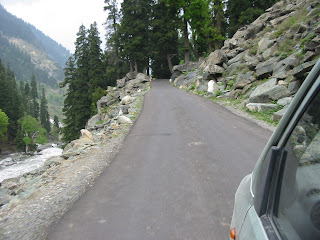Stop the Cloning of Cities!
Indian cities have been trying hard at developing into
clones of big cities across the world, and succeeding. (Aside: In the matter of
solid waste management they are just clones of each other). Bangalore was a
laid back garden city till about a couple of decades ago, even though it was the
aerospace-cum-electronics hub of India. If we put together all the pros and
cons of living comfort, standards of living, and quality of life, we will find
that the present Bengaluru has unfortunately lost its overall charm.
We have let globalisation and technological revolutions invade our urban spaces and our mind spaces so much, and at too fast a pace, that entire sections of urban residents have forgotten to pause, look around, smell the earth, and think of whole lots of other people to whom globalisation has meant deprivation, more financial burden and regress.
 |
| An area of the city, 8 Jan 2003 imagery |
 |
| Same area 27 Jan 2013 imagery |
Trivandrum (Thiruvananthapuram) is a uniquely endowed,
endearing, overgrown village. But it is increasingly obvious that this city is
also hurtling down the ‘progress and development’ path blindly, with foolhardy
zeal and no imagination whatsoever. Think of the city 20 to 30 years from now:
only more glass facades, more high-rise match boxes marring the green skyline,
and humongous concrete masses looking down on snarling traffic, tempers adding
heat to treeless avenues...
Mahatma Gandhi is said to have termed the city of Trivandrum as “Evergreen city of India”, blessed as it is with plenty of tree cover, and nestled on small hills between the Western Ghats and the coast.
It is evident that with globalisation, newer technologies and industries invade and take over / overtake the very thought processes of a city and end up thrusting a narrow concept of development. Prosperity and well-being of a city starts to be measured against such yardsticks as ‘world-class’ infrastructure and the upward mobility of city residents. The public have also been manipulated and steadily moulded to believe in advertised images and perceptions of what is desirable. The unnatural creation and projection of images of perfection and desirability by the media, advertising, marketing firms, and authorities who tout ‘global standards’ delude the masses into believing that their locality and the city will attain that kind of picture-perfection - if they have wider roads, bigger buildings, more indoor comfort and malls in which to ‘chill out’. (Parks and gardens aren’t ‘cool’ enough, you see).
If you stand on a stretch of MG Road, you can easily forget that it is MG Road, Thiruvananthapuram; it could be MG Road, any other city. Do we need that kind of development that swallows a city’s original character? Nearly all of India’s metropolitan areas and urban spaces have gone that way. Cities have expanded to encompass suburban areas and have become nightmares to residents and the already (mostly) clueless administrators. Delhi’s tentacles extend to several sub-cities, Mumbai grows into the sea leaving its heart far behind, Chennai pincodes have grown to 600117 and Bangalore’s now joyless veins clutch outer villages. Why is Ananthapuri being compelled to follow those models?
- Heritage structures and rich, green spaces on Government-owned land should be left intact, preserved for posterity while possibly serving some public purpose.
- All the remaining green and open spaces within city limits – precious few of them – should serve as well-maintained oxygen pockets.
- We need to reclaim, revamp and take care of public places that had had grandiose plans bestowed on them by successive Governments.
- Why can’t we - concerned city residents – play a role in defining our vision for the city, guided by the principles of aesthetics, abundant local wisdom, heritage preservation and Nature conservation?
In this context, it is good
to note the introduction of programmes like the new Urban Design Master’s
course offered at the CET, Trivandrum. Let us hope that such courses inculcate
a holistic, long-term vision for cities. The budding future town planners
should realize that there is much more at stake than the fortunes of the brick
and mortar industry.
A city’s growth lies not in
numbers of Big Retail, multiple ‘brandnamas’, outsize cars, cooler and swankier
malls, but in the numbers of residents who feel proud and happy about the right
things – health, clean air, welcoming public places, mind-invigorating outlook
of fellow-citizens. We must preserve what is left of the city’s character. Even
if it means calling a stop to mindless real-estate expansion and ridiculous
numbers of car dealerships.


Comments
Post a Comment
i appreciate that you have some thoughts to share, and are taking the effort to do so.